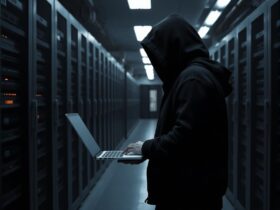The advancement of internet technology has many advantages. But, it also comes with its challenges. A study revealed that cyberattacks cost businesses of all sizes an average amount of $200,000. The world is advancing towards the use of the internet. Development of internet applications to offer services online has started. Since then, the rate of cybercrime has been increasing.
A Cyberattack is an effort to gain unauthorized access to a computer system. A Cyberattack can happen for various reasons, such as:
- Data theft
- Data deletion
- Network jamming to cripple services
- Data editing
Because of these dire consequences, Businesses should take up cybersecurity measures. Several methods help to keep your business safe from cyber-attacks.
With the recent development of ICS vendors, keeping your business secure is not a hard task. ICS vendors take the business’s specifications and then offer recommendations for controls to be used.
We will discuss the five main ways of securing your business’s cybersecurity.
- Use of Up-to-Date Software
There is no such thing as perfect software, contrary to common assumptions. Weak points can exist on websites or in computer applications. Hackers may be able to get access to the information system through these weak areas.
Even after the software gets released to the public, software engineers keep track of it. They analyze their software to spot any weak points or security flaws. When a developer detects a security issue in the software, they fix it.
The solution is then made available to existing users via a security patch update. With this in mind, you should make sure to keep your software and operating system up to date. If you do not keep your software up to date, you are leaving your data open to attacks.
Developers strive to make their software better as well. They include more security mechanisms in their programs. Software updates provide users with new security features. Failure to download and apply these updates is dangerous. It leaves your business open to new security threats.
- Cybersecurity Industry Standards
The energy industry was among the first industries to adopt the internet. The energy industry faced many attacks that had many bad effects. With this, the United States government decided to launch NERC.
The North American Electric Reliability Corporation (NERC) stated specific industry standards. All energy companies have to meet these standards. NERC came up with security standards too.
Once a company adhered to NERC’s standards, it would undergo an assessment. If the business passed the assessment, it would get NERC certification.
This started the development of security standards for various industry sectors. These standards would improve the reliability of various companies.
Cybersecurity standards are sets of best computing practices. Industry specialists and IT experts develop the standards. These standards protect businesses from cyberattacks.
The International Organization for Standards has come up with various standards. For example:
- ISO 27001- This standard describes the Information Security Management System requirements.
- ISO 27031- This standard provides common business continuity strategies. These strategies are for use after the occurrence of a cyberattack.
- ISO 27701- This standard outlines the necessities for a Privacy Information Management System. It is set according to the ISO 27001 standard.
Certification for industry cybersecurity standards can help boost the profits of a business. This is because clients will feel safe that their information is safe.
- Defensive Computing

Defensive computing is a computing practice that teaches users to avoid dangerous practices. They do this to reduce the likelihood of cyber-attacks occurring. In defensive computing, the ability to recognize business information assets is important.
Once all assets of a business are well identified, they are all secured. The assets get secured through defensive computing when accessing or using them. This helps to prevent attacks before they happen.
There are two types of defensive computing strategies that are:
- Backing up of data
- Network security
Information assets of a business should be prevented from unauthorized access. Network security methods prevent unauthorized access. Data backup and restoration solutions seek to reduce the amount of data lost. They are used in the event of a cyber-attack. Data backup also helps in re-establishing the information system’s former state.
The site Defensive Computing Checklist has a great list of defensive computing strategies. There are many defensive computing strategies for different areas of information technology.
- Multi-Factor Authentication
User authentication in information technology is the confirmation of an identity claim. These confirmations happen when logging into a system. There are three methods used to verify identity claims. These methods are:
- Biometric identification, for example, Retina scan, Fingerprint scan, etc.
- Access keys such as Identification cards, magnetic swipe cards, etc.
- Personal access phrases, such as passwords, pins, etc.
Most systems need one of the above-listed requirements for identity confirmation. This is less secure since items such as magnetic swipe cards can get stolen.
Multi-Factor authentication requires two of the above-listed methods for identity confirmation. Multi-Factor authentication gets included in the architecture of a system. Integration happens during the development of the system’s security layer.
An example of a multifactor authentication case is a user logging into a system. The user inputs their specific user name or email address and password. After this, the system prompts the user to place their finger on the fingerprint scanner.
When used with defensive computing, multifactor authentication is very good in preventing cyberattacks.
- Intrusion Detection

When it comes to observing the security of a system, there is a lot of focus on software protection. People are less concerned with actual hardware security. Starting a cyberattack is easy if an attacker accesses important hardware. An example of such hardware is servers.
You should set up access control methods in the location area for such hardware. The use of intrusion detectors can also help in improving system hardware security.
Intrusion detection is not for hardware only. Intrusion detection software is a major security component. They detect unauthorized system access or any unusual network activity. Intrusion detection software can help stop cyberattacks if all other security measures fail.
When the software detects unauthorized access, it notifies the administrator. The person in charge of cybersecurity can take immediate action.
Conclusion.
A business can take many cybersecurity steps. These steps will help to protect itself from different types of cyberattacks.
When setting up cybersecurity measures, businesses must have a cybersecurity plan. The cybersecurity plan will guide them through the process. Business representatives work with an information security specialist to build cybersecurity plans.














Leave a Reply